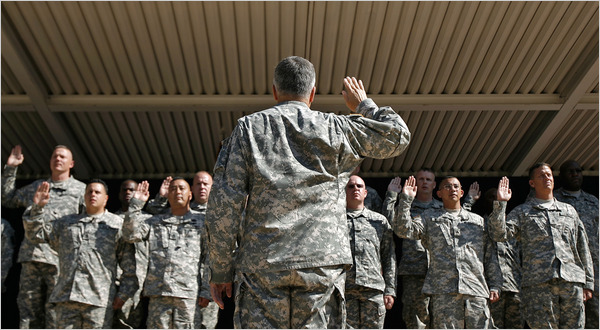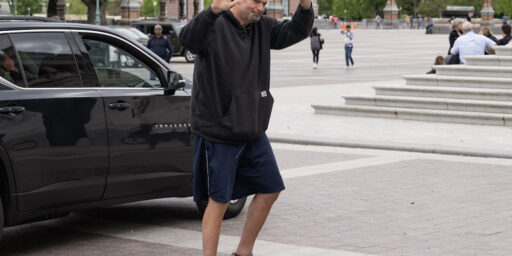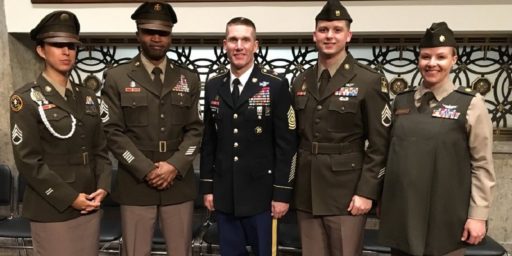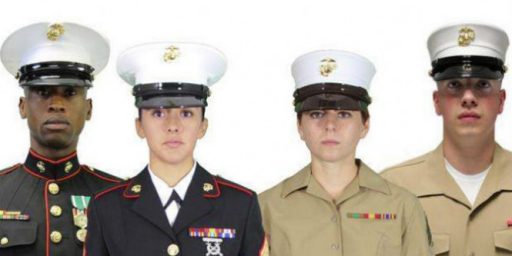Gates’ Pentagon Uni Policy

At a Pentagon ceremony in 2008, combat fatigues were worn by all, including Gen. George W. Casey Jr., the Army chief of staff. (Chip Somodevilla/Getty Images)
I missed the news last month that Defense Secretary Gates ordered his personal staff to start wearing their service uniforms to work at the Pentagon, reversing a post-9/11 tradition of all-fatigues-all-the-time. Whether desired or not, SECDEF’s move naturally has others nervously following suit, not only at the Pentagon but also in office environments across DoD.
Press Secretary Geoff Morrell was recently asked for clarification and he responded:
To give you the quick history of this, the secretary has for a long time been thinking about making a change in his office. When he came back from Christmas vacation, he asked his military staff to switch out of their BDUs, out of their fatigues, and into dress uniforms, their more appropriate work uniforms.
His thinking was simply that this is the headquarters of the United States military in our nation’s capital. He hosts leaders from around the world. The people we do business with, from across the river, the professionals that come to see us are all dressed in business attire. And he thought it was time for his office to be dressed accordingly.
This is — he understands fully why this building changed in 19 — in 2001 into its fatigues. This building was hit, it was attacked. We were at war. Not only was that the appropriate dress, in the aftermath of that attack, it showed solidarity with the warfighter.
I think we are at a point now where he believes at least that what one dresses in does not necessarily reflect their commitment to the warfighter or, and that there are other ways to demonstrate their solidarity. Frankly it’s by doing everything you can, once you walk in this door every day, to make sure they have what they need to succeed.
This was not a mandate for the building as a whole. This was meant for his staff. If others take notice, as they clearly have, and make adjustments, that is their decision. And I think you’ve seen some offices go about that.
You’ll certainly see the people you deal with in Public Affairs, starting Monday [March 1], dressed in their business or dress attire. And I think you’ll likely see other officers in the building as well. But it was not by fiat. It was not mandated. It’s — they’ve probably taken notice of the change upstairs and re-evaluated their own policies.
I don’t know what the policy was at the Pentagon in the pre-9/11 days but the Army as a whole was moving to all-fatigues-all-the-time as far back as the early 1980s. Even cooks and hospital personnel, who had traditionally worn whites to ensure cleanliness, were sporting BDUs. (Some commenters suggest my experience in this regard was idiosyncratic.) The idea was to inculcate the “warrior spirit” (hooah!) and demonstrate that all soldiers were warfighters.
Regardless, I’m with Gates — and Gulliver — on this one. It makes sense to have soldiers in line units wear utility uniforms to work. But for soldiers who work in an office environment — and especially those who represent the military to the public — service uniforms are more appropriate.
That’s especially true in the DC area, where everyone and his brother’s sporting a suit. I haven’t decided whether showing up to a business meeting in camouflage is more demeaning, insulting, or intimidating. Either way, it’s bad form.
I’m not advocating a return to the ridiculousness of the 1960s, when soldiers weren’t permitted to step out of their cars in fatigue uniforms once off post. But we’ve been at war now for the better part of a decade. We don’t need faux symbolism to make our soldiers feel like warriors.





James – I worked on the Army Staff before, during and after 9/11. Before 9/11 the uniform of the day was the Class B. Class A was reserved for formal meetings or ceremonies. BDUs were rarely, if ever, worn. All changed after 9/11 as you described here. It’s a little ridiculous trying telling people that you’re wearing the BDU/ACUs because we’re at war. People working in the Pentagon are no more likely to be in a shooting war (except in certain parts of DC) post 9/11 than they were on 10 Sep 2011.
I dunno, James. When I was stationed at Walter Reed in 1992-1993, we enlisted soldiers wore whites, a lot of NCOs wore class B, as did all the officers.
Interesting. At Fort McClellan, where my dad was stationed at the time, they made the switch somewhere in the early 1980s. And it seems like they were wearing BDUs everywhere at Fort Sill and overseas in the late 1980s.
This is step one on the road to getting rid of don’t ask don’t tell.
It is well-understood that the gays prefer the frilly, festooned, formality of the service uniform over the fatigues.
Once the gays are fully ensconced in the military, our once-proud fighting forces are going to look like Bad-era Michael Jackson.
I served my entire eight years during the “ridiculousness of the 1960“, and it didn’t seem ridiculous in the least. Service personnel were expected to project a professional image in public at all times. Of course, those were different times all around. In civilian life, ordinary people attending church were expected to wear only their best clothes. I think the casual dress concept slowly seeped through society as a result of the Hippie era.
I absolutely favor going back to wearing dress uniforms when off base. I think the sloppy appearance of the “bdu” and dungarees should be reserved for on base/ship and in battle. I’m not sure it shoud be as rigid as they were about it in my day, but there should be a dress uniform that is worn with a sense of self respect.
If they really want to signal solidarity with the guys in the field shouldn’t they be carrying 60 pound packs and turning the thermostat up to 110?
and
I think it’s reasonable for people who wear ACUs to work to be able to stop off and run quick errands without bringing a change of clothes. I’d prefer, though, if they’d change to civvies or Class A’s for going out to non-fast food restaurants and the like.
On the issue of uniforms–how about getting rid of them altogether?
If we really are in a “new” era where asymmetrical warfare is the norm, what good are uniforms?
We should blend in, operate clandestinely, and integrate our own asymmetricism to defeat the terrorists.
Walking around dressed like overgrown Boy Scouts just makes us sitting ducks.
It would also save the taxpayer money since we wouldn’t need to buy soldiers clothes. What kind of employer–other than those in the mindless service sector–buys its employees clothes?
Triumph… I think you are onto something here… First they will insist on wearing ribbons on their chests, then their arms and legs, then their hair…
Who knows what comes next?
Oh,… yeah,…. the downfall of western civilization.
Even in the ’60s we were allowed to wear work uniforms off base between 0800 & 1600 Mon-Fri for work details and for lunch at fast food joints. I went to downtown Honolulu a bunch of times in my dungarees. There was a time and place for everything. Heck, in the Philippines the wore white uniform trousers with undershirts in Subic Bay. That caused some difficulties because tee shirts don’t have rank insignia.
During my recently completed career in the Navy (medical corps) I spent almost all of my time assigned to USMC units. We essentially never wore work uniforms off base except while in transit to home in a POV. While one could get away with a quick stop to pick up dry cleaning or the like, that’s what you were doing: getting away with something. The rule of thumb I gave newly reporting personnel was if you wouldn’t wear ribbons on the uniform you shouldn’t wear it off base. It makes me grit my teeth now that I’m a civilian living and working near an army base and see soldiers wandering around town in their BDUs. Then again, I’m still working on my recovery
And good luck to you, young man. It’s been almost 50 years since I was in the Corps, and I haven’t recovered yet.
We never, ever wore our utilities off-base unless we were on some detail or other. I once made the mistake of having my overcoat unbuttoned when on liberty, in greens (I’d just come out of some restaurant and had neglected to button the thing up before hitting the street). I hadn’t taken two steps when some sergeant I’d never seen before comes around the corner, sees me, and starts yelling at me to button my goddamned coat up, etc., etc. Never have fingers flown so fast.
This policy change for the Sec Def’s staff WILL trickle down to far flung units and postings. In the Air Force, all the Major Commands base their “uniform of the day” wear based upon the Service’s Staff’s uniforms. Subordinate units, base their uniform wear on what their headquarters is wearing. It eventually trickles down to the Airman working the help desk at the MPF/CBPO or whatever they are calling the place today.
I remember more than one freezing briefing because in DC they wore Class B’s (shirts) and we were still in winter weather so a service dress jacket would have been nice.
Face it, except for Basic Training and one or two Service School (PME type) attendances, most of those in uniform now NEVER WEAR service dress. Oh, there are a few “old timers” (way younger than the “brown shoe Air Force” too), that feel it is important to wear all your decorations and trims, at least once in awhile.
It’s also another way to tell “who has pulled their weight” (combat and overseas duty ribbons) and who has skipped by, something we used to do all the time. Read the ribbons and the uniform.
Not everyone that deserves a medal gets one, and not everyone with a medal deserved it; But seeing a few Purple Hearts on someone, does change the “creds” balance.